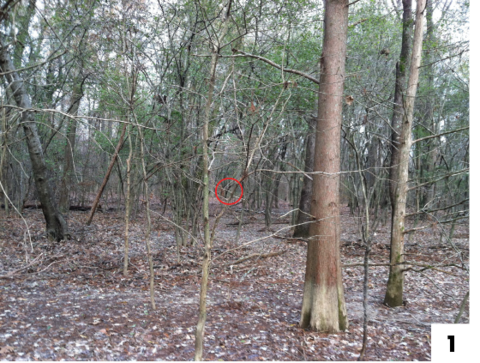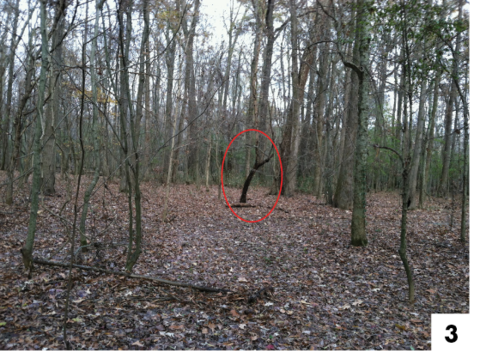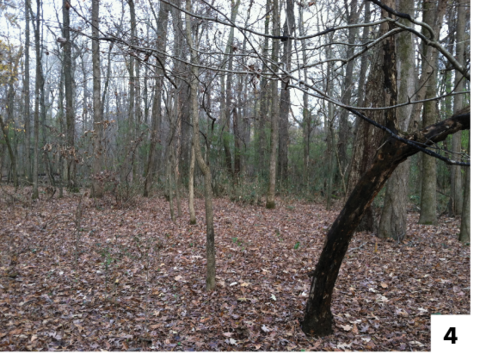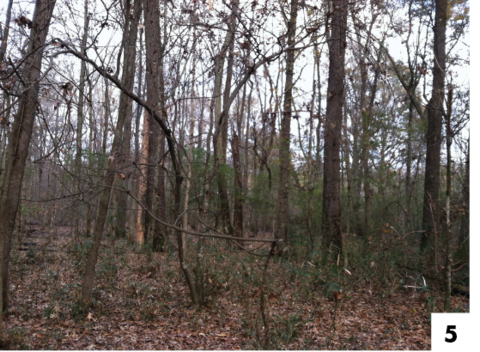P2004
Bottomland Hardwood Management Species/Site Relationships

Hardwood species selection is one of the most demanding forestry management tasks for private landowners and forest managers. Choosing the correct hardwood species for regeneration is difficult in part due to the large number of species available and their varying needs for survival and growth. In many cases, the needs of different species may only be met by a combination of factors that exist only under different site and soil conditions. To manage hardwoods well, you should understand the nutritional and moisture needs of the main commercial hardwood species and the types of soil that best meet these needs. In general, the most desirable species will survive and grow well only on a narrow range of sites and conditions. Correctly matching species to site will result in a stand capable of growing and thriving over an extended period of time.
Bottomland Hardwood Sites
All forested sites in the South can be divided into different types of physical geography: uplands, terraces, and floodplains. Uplands are the most common type, with soils in these areas formed through natural weathering processes from parent geologic material or wind-blown materials. Terraces are old floodplains of current or ancient streams. The alluvium in these soils made them fertile at first, but they become less productive due to nutrient depletion over time. The nutrient levels in older terrace soils have been depleted in many cases. Many older terrace soils also develop layers called hardpans that limit growth.
The term “bottomland hardwoods” generally refers to hardwoods found on current floodplain sites. Soils on these sites are young because they are made of recent stream deposits. They vary in drainage and nutrient levels, thus resulting in a range of sites with different productivity levels appropriate for different hardwood species.
Floodplain sites in the South are divided into major river bottoms and minor stream bottoms. The obvious difference between them is the size of the stream. Major river bottoms are usually associated with large rivers, such as the Mississippi River. Another important difference is in the kind of soil deposits. The alluvium in major river bottoms can come from hundreds or even thousands of miles away. It may be made up of materials of a variety of textural classes and nutrients. In minor stream bottoms, alluvial deposits are local and usually less variable in texture and nutrients. For these reasons, major river bottoms are often, but not always, more productive than minor stream bottoms.
Bottomland hardwoods mainly occur in the Atlantic and Gulf Coastal Plain divisions of the Coastal Plain Province. That’s because the nature of soils in these areas is sedimentary and easily eroded. When the climate was much warmer and wetter, ancient streams eroded away material to form stream valleys. These streams continue to deposit rich sediments. Today, about 30 million acres of bottomland hardwoods are left in the South. This acreage is about one-half of the estimated coverage at the time of European settlement. The change is the result of factors like urbanization and farming. A prime example of this loss is in the Mississippi Delta where the Mississippi River was leveed to protect cities and valuable rich crop lands from annual flooding.
Site Variation
Site variation within floodplains is mainly associated with elevation differences, where a change of as little as 6 inches of elevation can change the suitability of a site for some species. Elevation differences cause changes in drainage class and soil moisture. Even small elevation differences can result in different soil type, texture, structure, and pH. All of these impact species occurrence and growth. Differences in both topography and parent material alter the way materials are deposited and streamflow within the floodplain.
Figure 2 is a sample cross section of a major stream valley of the coastal plain. It shows topographic features and their usual sequence. Each topographic feature shown may occur several times. Additionally, these features may not occur in the order shown. Ridges and swamps are far more common in the Atlantic Coastal Plain than they are in the Gulf Coastal Plain. This difference is because of the way floodplains formed.
The paragraphs below describe topographic features shown in Figure 2. Each section also gives the hardwood species commonly found on each feature in major river bottoms. The species listed may or may not be desirable in terms of timber value, but species listed in the table at the end of this publication are desirable. In major river bottoms, the types of trees will vary depending on soil age and successional stage.

Bars
Bars are formed when the concave section of a stream bank erodes and sediment is deposited downstream on an opposite convex area of the stream. With time and increasing deposits, the bar may become a mud flat. With more deposits, the flat may become a front. Bars are typically very wet and often flooded.
Here, black willow is the major pioneer species, but if the land is elevated enough or becomes established between high water levels, eastern cottonwood may also grow. Black willow is more tolerant of water. Both species can withstand some sediment deposition, but if a front forms, they may be replaced by front species.
Fronts
Fronts are the best sites for tree growth in the floodplain. These are natural levees that form when streams overflow their banks and quickly deposit sediment. Deposited soil is usually of a sandy texture. Consequently, these areas are usually the highest sites with the best drainage. Fronts usually flood only during extreme conditions. Almost all hardwood species can grow on these sites.
Cottonwood is the primary species found on fronts, usually followed by elm, sycamore, sweet pecan, sugarberry, boxelder, and sweetgum. In many places, fronts appear to be two-tiered stands with cottonwoods in the overstory and other species in the understory. The cottonwood overstory allows enough sunlight to reach the forest floor for other hardwood species to regenerate and develop. This front stand is not final but rather sets the stage for other species that will replace those that originally occupied the site.
If replacement is rapid (caused by humans or natural disaster), a red oak and sweetgum stand may grow. If replacement is slow, the stand may turn into a mixture of boxelder and sugarberry or a mixture of boxelder, hackberry, and silver maple. As the site matures, it may again be occupied by sweetgum and red oak. The pH of these soils can greatly affect species combinations, as high pH will greatly inhibit the ability of oaks to occupy these sites. The main exceptions to this rule are Shumard and overcup oaks, which can tolerate higher pH soils.
Flats
A flat is a broad, smooth area between two ridges or between a ridge and a front. The soils are mostly clays. Drainage varies from poor to somewhat poor, but standing water is usually absent during most of the growing season. There may be slight elevation differences. Variations classified as “high flats” and “low flats” are based on drainage patterns. Flats make up the largest area in the floodplain. Flats represent a major change in site quality, as they are not as suitable for growing the most desirable species.
Various tree species grow on flats. On low flats, overcup oak, water hickory, and cypress dominate. Pure stands of overcup oak are common in some places. On high flats, the most common group is elm, ash, and sugarberry. Other species, such as Nuttall oak, willow oak, and red maple are also common on these sites. Occasionaly, Nuttall oak and willow oak will dominate these stands.
Ridges
Ridges are old fronts and are the second best sites for hardwoods. While these areas could vary in elevation from 2 to 15 feet above flats, an elevation gain of 2 or 3 feet is more common. Drainage may not be quite as good as on fronts, and soil fertility may be somewhat lower. Soil textures tend to be coarser than those in flats, and drainage is better.
Past events and treatments will affect species occurrence on ridges. A combination of elm, ash, and sugarberry is the most common, but if the site is opened rapidly and appropriate regeneration is present, it can be replaced by a stand composed of sweetgum, red oak, water oak, willow oak, cherrybark oak, Shumard oak, and a variety of minor species. Without management, these stands typically go back to an elm, ash, and sugarberry mix.
Sloughs
Sloughs are shallow depressions formed from old stream channels that have nearly filled with sediment. They are low areas with poor drainage because of heavy clay soils that result in standing surface water well into the growing season. These areas support lower quality and less desirable timber tree species, such as overcup oak and water hickory.
These areas are usually occupied by baldcypress, water tupelo, and willow. Depending on how close the slough is to a stream or if sedimentation occurs rapidly, higher quality stands of black willow may occupy the site. If sedimentation continues, the black willow will be replaced by elm, ash, and sugarberry. On sites where sediment is deposited slowly some distance from the stream, overcup oak, water hickory, and green ash will most often follow willow.
Swamps
Swamps are also old stream channels, but they are deeper than sloughs. Surface water is usually present year-round. Most species will not grow in these areas. Bald cypress and water tupelo tend to thrive but do require dry conditions to regenerate.
In swamps of major river bottoms, baldcypress and water tupelo are the most common species. Depending on depth and duration of flooding, other tree species that sometimes grow include swamp tupelo, water elm, Carolina ash, water hickory, swamp laurel oak, and overcup oak.
Species Occurrence
While a large number of hardwood species occur on floodplain sites, only a few are considered desirable for timber production. Table 1 shows desirable timber trees by site type. The table is not a complete listing of all species, but species listed are considered to be the most appropriate for those sites.
There are other wet sites that support hardwood growth but are not associated with stream floodplains. Sites such as coastal and muck swamps often grow hardwoods due to their lack of suitability for pine species. Generally, these sites are not as productive as floodplains, and hardwoods growing there, usually baldcypress and water tupelo, are of low quality.
Minor stream bottoms are just smaller versions of major river bottoms. They have the same physical features, and most of the same species can be found on these sites. Species that occur only on ridge positions in major river bottoms often occur on flats in minor bottoms. River birch is the most common pioneer species on new land such as bars and mud flats. Many different types of trees grow on fronts and may include yellow poplar, American beech, sycamore, spruce pine, sweetgum, cherrybark oak, Shumard oak, water oak, swamp chestnut oak, and several species of hickory.
Although flooding still occurs, other natural forces usually control succession and species on these sites. Typical species growing on well-drained flats and ridges of minor bottoms include sweetgum, cherrybark oak, water oak, swamp chestnut oak, American elm, and hickories. On less well-drained flats, the major species include overcup oak, willow oak, Nuttall oak, swamp laurel oak, persimmon, green ash, sugarberry, and red maple. Tree species growing in sloughs of minor bottoms will vary depending on the duration of flooding. Cypress, swamp tupelo, water tupelo, and water elm are most commonly found where flooding is extended. Overcup oak, water hickory, and persimmon will also occur where flooding is not as severe.
| Topographic Position |
Desirable/Suitable Species for Major River Bottoms |
Desirable/Suitable Species for Minor Stream Bottoms |
|---|---|---|
|
bars |
cottonwood and black willow |
river birch and black willow |
|
fronts |
cottonwood, sycamore, sweetgum, sweet pecan, green ash, water oak, cherrybark oak1, swamp chestnut, oak1 |
cherrybark oak, Shumard oak, sycamore, sweetgum, yellow poplar |
|
ridges |
willow oak, water oak, sweetgum, sycamore, green ash, cherrybark oak1, swamp chestnut oak1 |
cherrybark oak, Shumard oak, swamp, chestnut oak |
|
high flats |
Nuttall oak, green ash, sugarberry, willow oak |
cherrybark oak, water oak, willow oak, Shumard oak, swamp chestnut oak |
|
low flats |
overcup oak, water hickory, green ash, persimmon, sugarberry |
willow oak, overcup oak, persimmon, green ash |
|
sloughs |
overcup oak, black willow, water hickory |
overcup oak and persimmon |
|
swamps |
baldcypress and water tupelo |
baldcypress, swamp tupelo, water tupelo |
1Species may not be found on sites in the Mississippi River floodplain.
Implications for Use or Management
The most important part of hardwood regeneration and management is correctly matching species and sites. Factors that influence this selection include topographical features, elevation, soil characteristics, presence of pans, pH, and hydrology. Soil maps and site visits throughout the year will help you decide which hardwood species would grow best in a given area. In most cases, it is better to include a combination of hardwood species and not a single species because of site variability.
If hardwood management objectives include timber, wildlife, or a combination of the two, you must understand species/site relationships and forest succession. Reforestation or afforestation projects are likely to fail if species and sites are not correctly matched. Remember that bottomland ecosystems do change. With or without human influences, forest stands will continue to change species. What is found there today may not be there 100 years from now. Current stand and site conditions can progress a stand toward several different stages of forest succession.
The species/site relationship concepts discussed in this publication can help you make management decisions that could resolve or reduce conflicts over the use of bottomland hardwood resources. These areas are quite diverse and can accommodate a great variety of interests and uses. You can use active management to keep or increase species diversity of forest stands while meeting other objectives. Hardwood management is complicated, and understanding species/site relationships is not easy. If you are uncomfortable with making management decisions in these systems, please contact a consulting forester, a Mississippi Forestry Commission area forester, your local MSU Extension agent, or an Extension forestry specialist for help with these important decisions.





Figure 3. This series of photographs carries you away from the stream bank in a minor stream bottom. A distance of approximately 100 yards and a gain of 2 feet in elevation is encompassed by this series. In the first photograph, the site floods regularly and supports a baldcypress/water elm mixture. As site drainage improves over the next two photographs, site conditions have allowed for successful establishment of a green ash, elm, and sugarberry stand. Continual gain in elevation results in a species shift to water oak and sweetgum by the fourth photo. At a gain of approximately 2 feet in elevation, the ridge in the fifth photograph supports a healthy water oak, cherrybark oak, and sweetgum mixture. While some of the species observed are capable of growing on multiple topographic sites, some are not. Careful consideration of species/site relationships helps avoid management problems that arise when trying to maintain ill-suited species on improper sites.
Publication 2004 (POD-12-23)
Revised by Brady Self, PhD, Associate Extension Professor, Forestry, from an earlier version by Andrew W. Ezell and John D. Hodges, Professors Emeriti, Forestry.
The Mississippi State University Extension Service is working to ensure all web content is accessible to all users. If you need assistance accessing any of our content, please email the webteam or call 662-325-2262.
